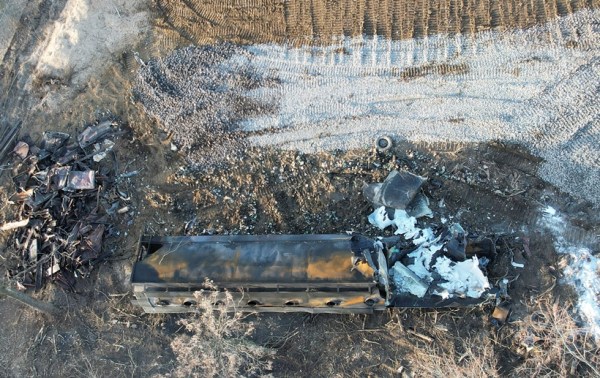Investigation Into Toxic Chemical Persistence After Ohio Train Derailment

Table of Contents
Types of Toxic Chemicals Released and Their Persistence
The Ohio train derailment involved the release of numerous hazardous chemicals, raising serious concerns about their persistence in the environment. Understanding the properties and persistence of these chemicals is vital for assessing the long-term risks.
Vinyl Chloride and its Degradation Products
Vinyl chloride, a known carcinogen, was among the chemicals released. Its persistence in soil and water is a significant concern.
- Half-life of vinyl chloride: Vinyl chloride's relatively short half-life in the environment doesn't negate the risk. Even after decomposition, it can form harmful byproducts.
- Potential for groundwater contamination: Its mobility in soil increases the risk of groundwater contamination, posing a long-term threat to drinking water sources.
- Health risks associated with long-term exposure: Long-term exposure to vinyl chloride and its degradation products is linked to an increased risk of liver cancer, brain cancer, and other serious health problems.
Other Hazardous Materials
Besides vinyl chloride, other hazardous materials released include butyl acrylate, ethylene glycol monobutyl ether, and others. Each poses unique challenges regarding persistence and toxicity.
- Persistence in different environmental matrices (soil, water, air): The persistence of these chemicals varies depending on the environmental medium (soil, water, or air), influencing the extent and duration of contamination.
- Bioaccumulation potential: Some of these chemicals have the potential to bioaccumulate in the food chain, posing risks to wildlife and potentially impacting human health through consumption of contaminated food.
- Long-term health impacts of each chemical: The long-term health impacts of these chemicals are still being investigated, but preliminary data suggests potential respiratory problems, neurological issues, and other health complications. The synergistic effects of exposure to multiple chemicals also warrant further investigation.
Environmental Impact Assessment and Monitoring
Assessing the environmental impact of the derailment is a complex and ongoing process. Various methods are employed to monitor the extent of contamination and its spread.
Soil and Water Contamination
Extensive testing is underway to determine the levels of soil and water contamination.
- Contamination levels detected: Initial reports indicate significant contamination levels in the immediate vicinity of the derailment site, with ongoing testing to determine the full extent of the impact.
- Areas most affected: The areas most severely affected are those immediately surrounding the derailment site, but the extent of the contamination may be broader.
- Challenges in remediation efforts: Remediation efforts are facing challenges due to the complex nature of the contamination and the various chemicals involved. Effective strategies are being developed to address these challenges.
Air Quality Monitoring
Air quality monitoring is crucial to assess the impact of airborne pollutants.
- Detected pollutants: Various air pollutants were detected in the aftermath of the derailment, including vinyl chloride and other volatile organic compounds.
- Peak concentration levels: Peak concentration levels of these pollutants were recorded shortly after the incident, with concentrations gradually decreasing over time.
- Health advisories issued: Health advisories were issued, advising residents to stay indoors and take precautionary measures to minimize exposure.
Long-Term Health Effects on the Community
The long-term health effects on the community remain a significant concern.
Reported Health Issues
Residents have reported a wide range of health issues following the derailment.
- Number of reported cases: The number of reported cases is continually evolving as more people seek medical attention.
- Types of symptoms: Reported symptoms include respiratory problems, headaches, nausea, skin irritation, and other symptoms.
- Ongoing medical studies and assessments: Several medical studies and assessments are underway to better understand the long-term health consequences of this incident.
Potential Long-Term Consequences
Exposure to the released chemicals could have long-term health consequences.
- Latency periods for various cancers: Many cancers have long latency periods, meaning that the effects of exposure may not become apparent for years or even decades.
- Ongoing research into long-term health impacts: Extensive research is needed to fully understand the long-term health effects of exposure to the chemicals released in the derailment.
- Need for long-term health monitoring programs: Long-term health monitoring programs are crucial to track the health of the affected community and to identify potential long-term health effects.
Government Response and Regulatory Actions
The government's response to the derailment has included investigations and remediation efforts.
Investigation and Remediation Efforts
Various agencies are involved in investigating the cause of the derailment and in implementing remediation strategies.
- Agencies involved: Multiple federal and state agencies are involved in the investigation and cleanup efforts.
- Remediation strategies employed: Various remediation strategies are being employed to address the contamination, including soil removal, water treatment, and air purification.
- Challenges in cleaning up the contaminated sites: Cleaning up contaminated sites is a complex and challenging process that requires specialized expertise and resources.
Regulatory Changes and Future Prevention
This incident highlights the need for improved regulations and safety measures.
- Proposed legislation: Several proposals have been made for new legislation to improve the transportation and handling of hazardous materials.
- Improvements in safety regulations: There is a growing push for stricter safety regulations to prevent future incidents of this nature.
- Enhanced emergency response protocols: Improved emergency response protocols are essential to effectively manage future hazardous materials incidents.
Conclusion
The Ohio train derailment serves as a stark reminder of the potential for catastrophic consequences when hazardous materials are mishandled. The investigation into toxic chemical persistence is ongoing, and its long-term environmental and health impacts are still unfolding. The key takeaways are the diverse range of persistent toxic chemicals released, the significant environmental contamination, and the potential for serious, long-term health consequences for the community. The need for continued monitoring, comprehensive remediation efforts, and stringent regulatory changes cannot be overstated. The ongoing investigation into toxic chemical persistence following the Ohio train derailment underscores the urgent need for comprehensive long-term monitoring and preventative measures. Stay informed, advocate for stronger safety regulations, and demand accountability to protect our communities from future disasters.

Featured Posts
-
 Fox News Faces Defamation Lawsuit From Ray Epps Over Jan 6th Coverage Allegations Of Falsehoods
Apr 28, 2025
Fox News Faces Defamation Lawsuit From Ray Epps Over Jan 6th Coverage Allegations Of Falsehoods
Apr 28, 2025 -
 Abwzby Tstdyf Mntda Rayda Llabtkar Fy Tb Alhyat Alshyt Almdydt
Apr 28, 2025
Abwzby Tstdyf Mntda Rayda Llabtkar Fy Tb Alhyat Alshyt Almdydt
Apr 28, 2025 -
 Alnskht Althanyt Waleshrwn Mn Mhrjan Abwzby Brnamj Hafl Balnjwm
Apr 28, 2025
Alnskht Althanyt Waleshrwn Mn Mhrjan Abwzby Brnamj Hafl Balnjwm
Apr 28, 2025 -
 Eva Longoria Raves About Top Chefs Fishermans Stew
Apr 28, 2025
Eva Longoria Raves About Top Chefs Fishermans Stew
Apr 28, 2025 -
 Coras Subtle Lineup Shift For Red Sox Game 1
Apr 28, 2025
Coras Subtle Lineup Shift For Red Sox Game 1
Apr 28, 2025
